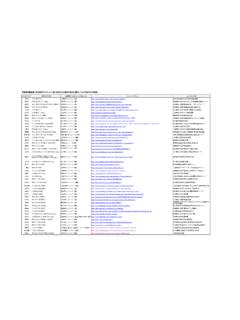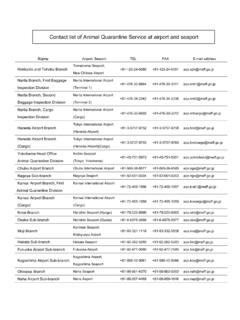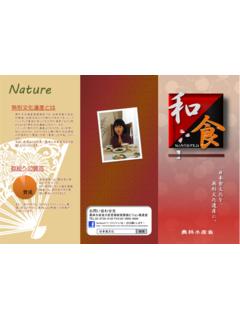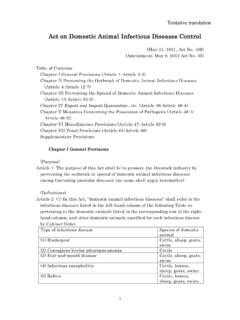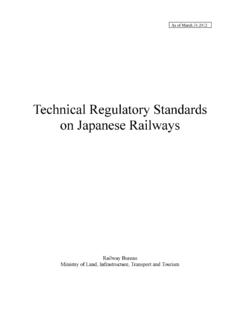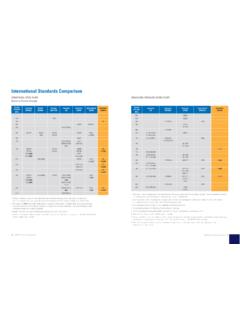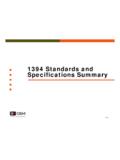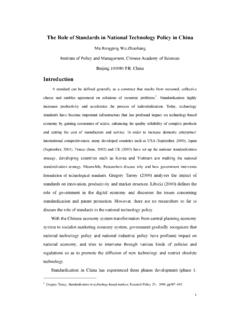Transcription of 0703Overview of the Organic JAS - maff.go.jp
1 Overview of the Organic japanese Agricultural Standard SystemStandard and Labeling DivisionFood Safety and Consumer Affairs BureauMinistry of Agriculture, Forestry and FisheriesMarch 2007 Content1. Inspection and Certification System2. The japanese Agricultural Standard for Organic agricultural product3. Other japanese Agricultural Standards for Organic foods and feeds4. Relevant legislations and criteria1. Inspection and Certification SystemBackground for the elaboration of the Organic JAS system- Adoption of International GuidelinesThe Codex Guidelines for the Production, Processing, Labeling and Marketing of Organically Produced Foods (GL32), adopted by The Codex Alimentarius Commission in 1999- Revision of the Law Concerning Standardization and Proper Labeling of Agricultural and Forestry Products (JAS Law) in 1999-- Introduction of the inspection and certification system for Organic foods-- Elaboration of the principle of Organic production as the Organic JAS in 2000-- Prohibit misleading labeling to products without the Organic JASThe japanese Agricultural Standard for Organic agricultural products- Elaboration of the principle of Organic production in line with the Codex Guidelines- Labeling of Organic by certified producersOnly producers certified by registered certifying bodies accredited by the Minister of Agriculture, Forestry and Fisheries are able to label as Organic and attach the Organic JAS mark to the Inspection and Certification System SchemeMinister of Agriculture, Forestry and FisheriesRegistered certifying bodiesProduction process managersManufacturersRe-packersRetailers Consumerscertificationaccreditation2.
2 The JAS for Organic agricultural productsKey features of the standard1. Use of composts and non use of prohibited agricultural chemicals and fertilizers for no less than two years before sowing or planting2. Non use of prohibited agricultural chemicals and fertilizers for production periods3. Non use of recombinant DNA technologyThe criteria for the method of production provided by article 2 Natural recycling function of agriculture should be maintained or increased by:- non use of chemically synthesized fertilizers and agricultural chemicals;- exercising the productivity of the soil; and - applying the cultivation method to minimize loadto the environment as much as possibleThe criteria for the method of production provided by article 4 Conditions for fields- Use of composts and non use of prohibited agricultural chemicals and fertilizers for no less than 2 years before sowing and planting (3 years for perennial plants)- Under the proper management so as to prevent drifting and flowing of prohibited substances during the production periodsManuring practice- The productivity of the soil should be maintained or increased by composts from residues of products in the fields.
3 And the use of functions of organism in the fields or in the surrounding The use of fertilizers and soil conditioners may be permitted only in cases where the methods identified above are not effective for maintaining or increasing the productivity of the criteria for the method of production provided by article 4 Major fertilizers and soil conditioners in Attached Table 1 Natural substances or those derived from natural substances without the use of chemical treatment and chemical additives-composts- fertilizers of animal and plant origins (substances from food industries)- fertilizers of mineral origin (source of P, K, Ca, Mg, S Si - trace elements- soil conditioners of mineral origin (perlite, vermiculite and others)- Use of organically produced seeds and seedlings- Use of seeds for seed reproductive plants and the youngest available seedlings for vegetative reproductive plants- Non use of recombinant DNA technologyCriteria for seeds and seedlings-Mechanical cultivate, physical or biological protections or in combination- The use of agricultural chemicals in Attached Table 2 may be permitted only in cases of imminent or serious threat to the crop and where the measures identified above are not effectiveControlling noxious animals and plantsMajor agricultural chemicals from Attached Table 2- Those of plant originpyrethrins, canola oil, lecithin, lentinus edodes mycelium extract liquid- Those of mineral originsulfur, Bordeaux mixture - Biological control and biopesticide formulationnatural enemy-Other sex pheromone agent, metaldehyde, carbon dioxide3.)
4 Other JAS for Organic foods and feeds- The JAS for Organic livestock productsIn lines with the method of production of Organic livestock products, adopted by the Codex Alimentarius Commission in 2001- The JAS for Organic feedsFor feeding Organic livestock- The revision of the JAS for Organic agricultural processed foodsInclude the definition of Organic livestock processed foodsThe JAS for Organic processed foodsKey features of the standards- The use of chemically synthesized food additives and chemicals should be the last Final products contain no less than 95 % of Organic ingredients, other than water and salt- Non use of recombinant DNA technologyThe JAS for Organic livestock productsKey features of the standard- Provide organically produced feeds- Rearing management such as regular exercise and access to pasture and/or open-air runs, so as not to stress livestock- Non use of antibiotics for the purpose of preventing diseases- Non use of recombinant DNA technology4.
5 Relevant legislations and criteria- The Law Concerning Standardization and Proper Labeling of Agricultural and Forestry Products (JAS Law) (Law of No. 175, 1950)- Enforcement Ordinance of the JAS Law- Enforcement Regulation of the JAS Law- Technical criteria for certifying production process managers etc. of Organic agricultural products and Organic feeds, The inspection method of production process of Organic agricultural products, Organic processed foods, Organic feeds and Organic livestock



